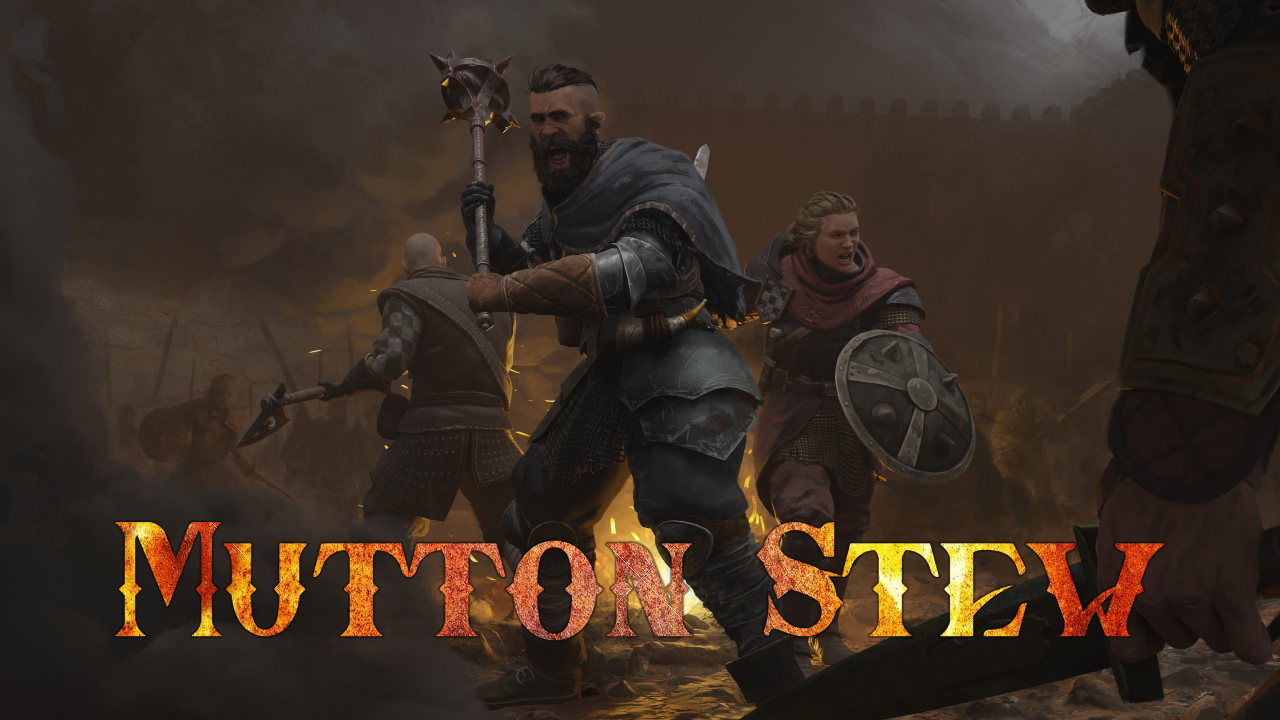Playing the Wartales demo during the Steam Next Fest did not endear me to the game. So how did I end up with 188 hours of game time (allegedly, by Xbox for PC measurements) and a very long review of it? For one, a friend I really highly respect recommended it to me. And that recommendation kept me playing long enough to appreciate what a labor of love Wartales is.
I knew nothing about the game world before setting out, but I’ve learned a lot more in the travels. Wartales is set in an alternate medieval world. The player enters as the local equivalent of a startup: five guys dressed in rags and armed with rusty weapons, all hoping to make a living as mercenaries. The region that will witness their rise to fame and glory is the territory of the former Alazarian empire. It’s rife with conflicts, intrigue, banditry, wild beasts and other opportunities for swords-for-hire.
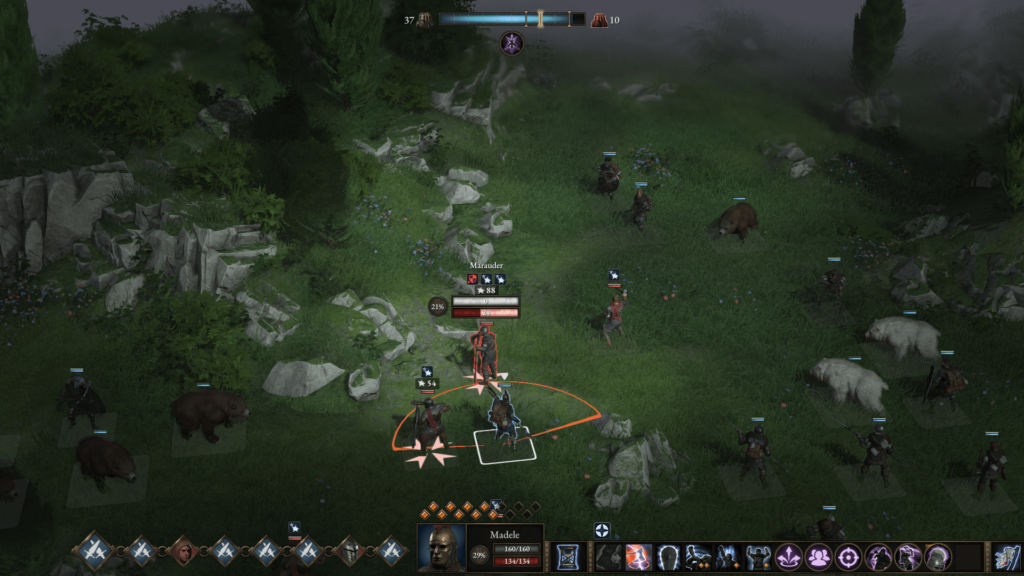
So it’s like Mount & Blade without horses or Battle Brothers with an even lower fantasy setting.
There are no central characters in Wartales, only your group of mercenaries. You can shape the starting class mixture somewhat as well as choosing a small starting bonus and penalty, but that’s that. Mount and Blade this is not, but at least you get to customize your crew with cosmetics. As time goes on, you’ll professionalize with banners and lieutenants and captive animals. Before long, you’ll have a warband forty-strong!
Just like in Mount and Blade or Battle Brothers, you will move this group around the world map in real time before. Once you encounter enemies, you’re taken to a skirmish map for some turn-based tussle. A small, but cute and immersive detail is that all groups on the campaign map appear exactly as they are, with each member depicted with their equipped gear. This way, you can gauge the strength of enemy groups even without looking at the color of their icon.
It’s a whole world out there, Charles Mercenary
Speaking of enemy strength: Wartales lets you choose between either a region-locked exploration or an adaptive world. Region-locked exploration fixes each region (dutchy/county/etc.) to specific level ranges. You start in Tiltren, and you’ll be able to freely return there dozens of hours later and immediately rout any opponent by one-punch ethering the group leader.
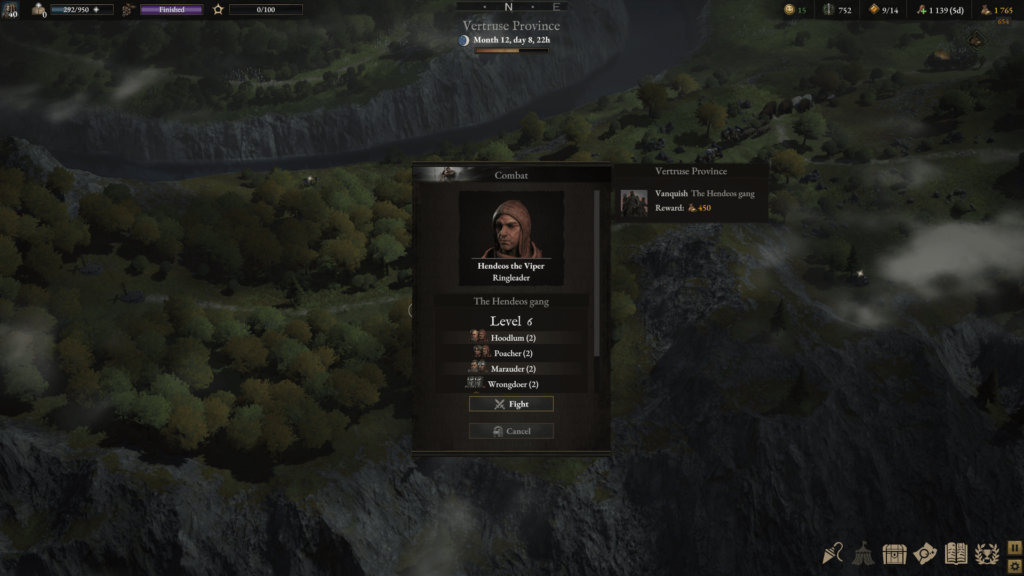
Adaptive, on the other hand, will keep the appropriate level of challenge no matter where you go. I chose region-locked to maintain at least some feeling that I’m becoming powerful when compared to the rest of the world. I am tired of games always undoing any sense of progress by spawning the same roadside bandits through the entire playthrough, but in increasingly expensive armor.
I’m still not over Oblivion.
Back to Wartales: if I crossed into another region while being a bit overleveled, well, then I would have my deserved powerful entry. But if a region proved too tough, that would be a sign to go back and complete my business in the previous one.
In theory.
Unfortunately, that system only works if you’re:
- not a buffoon who is slightly overleveled because he completed every quest in the previous region;
- capable of understanding that the difficulty spike in the new region is a sign that you should go somewhere else.
That was me, I was the buffoon. Two regions worth of leveling later, I discovered what the game intended to have been my second region. And then I encountered something that reminded me of my Freelancer playthrough: going back to Liberty (the starting region) after finishing the game and being able to effortlessly beat anything their start-of-game-level forces throw at you is a bit sad.
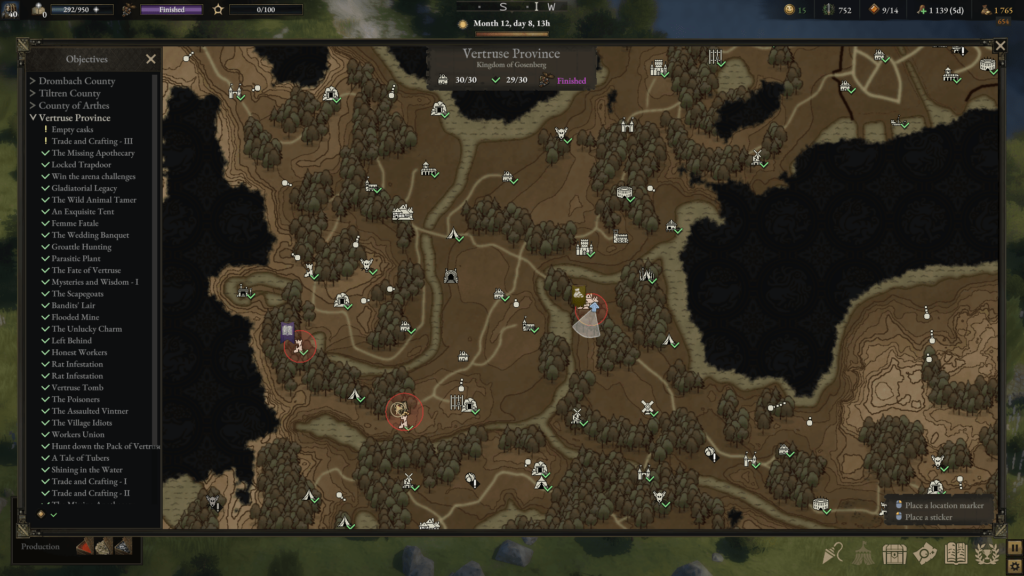
So guess how that feels when you encounter a whole new region with Wartales, with their quests and rewards now respectively trivial and insignificant, just because you’re a thick-skilled dingus who succeeded in bashing the wall down with their skull?
Maybe… maybe you should use adaptive in your playthrough of Wartales. But if you’re laboring under region-locked exploration as intended, you will soon notice that each region has a multi-quest region-wide plot going.
In Tiltren, for example, the conflict is between the refugees fleeing the civil war in neighboring Edoran and the locals who would rather not have their stuff nicked by the hungry and the desperate. Both sides have their own reasonable people and reactions, both feature those who take their “faction’s” goal to the ugly extremes. Who will you ultimately side with?
OK, bad example, there was no way I was not gonna go with the refugees, but you know what I mean.
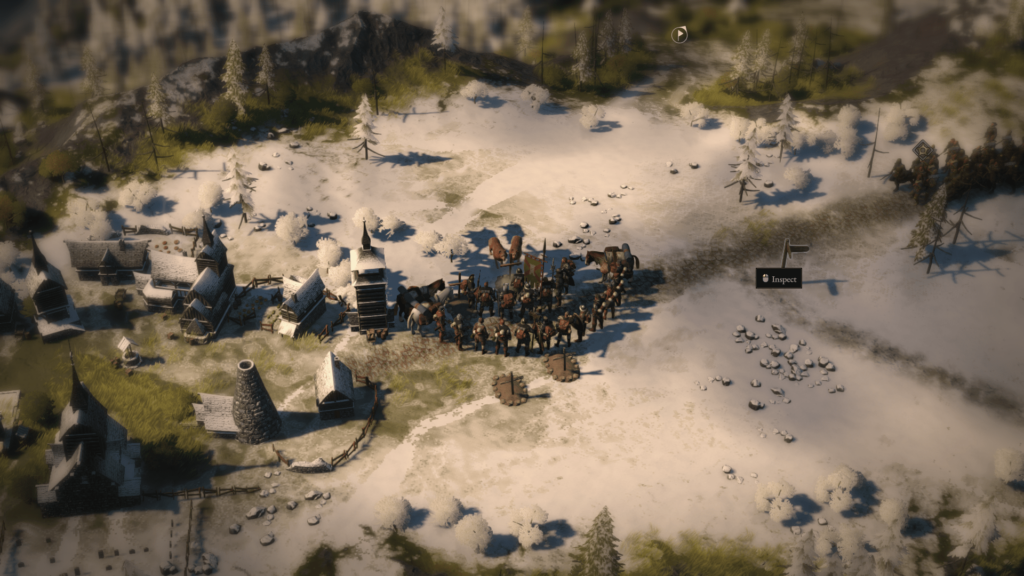
Outside of the main quest, there will be farms, estates and camps aplenty with their own problems small and large, all of which could use the help of a group of armed and dangerous travelers. And the plots are written quite intelligently, offering their own twists and turns on what would be stock tropes in weaker works. Plus, there are plenty of situations where you can resolve the quests non violently – and that’s in a game called “Wartales” that has almost no character stats or skills for non-combat stuff.
Putting “war” in “Wartales”
Right, so, combat, lest we forget what we’re here for. It’s turn-based with alternating activations. When it’s your turn, you can choose to activate any of your warriors that hadn’t acted yet. But the enemies act in fixed order and you always know who’s gonna go next (and 2nd, and 3rd). So you have a lot of flexibility, especially since your troopers aren’t limited to the neo-XCOMian one-move-one-action meta. You can move, act, and move again no problem. But there are catches.
For one, if you engage an enemy who isn’t already in a fight, they become locked in combat – and disengagement provokes an opportunity attack. Secondly, you’re going to have but a single free attack conferred by your weapon. All the other abilities – boosting allies, bestowing status effects, etc. – will cost Valor points.
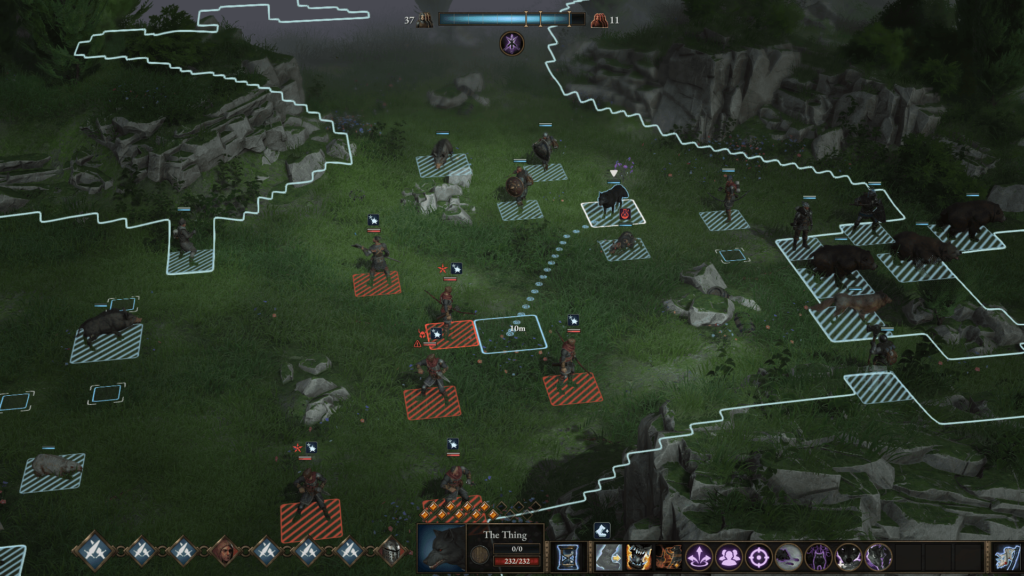
Valor points can be gained in battle (and it becomes a lot easier as your group grows in strength), but you’ll want to have a good reserve coming into a fight. It’s absolutely vital for activating class abilities. Your brute swinging their mace in an arc, poisoning everyone he hits? That’s two Valor points – and that’s expensive!
On the other hand, that same brute can learn the ability to get a Valor point for hitting more than one enemy with an attack. You can probably see a synergy starting to appear – especially when you consider that some of the weapons available to that class are multi-target.
Now, classes are defined by more than their abilities. Durability also varies a lot. In Wartales, a warrior has Health points which mostly remain untouched until you deplete their Armor. Meanwhile, their Armor can be really tough to crack due Guard rating, which reduces damage while you still have at least a point of Armor. Of course, not all classes can load up on that, so your archers will have to rely on range (and potential assailants being engaged by melee-oriented friendlies) while rangers (read: assassins) will go after enemies that are already engaged.
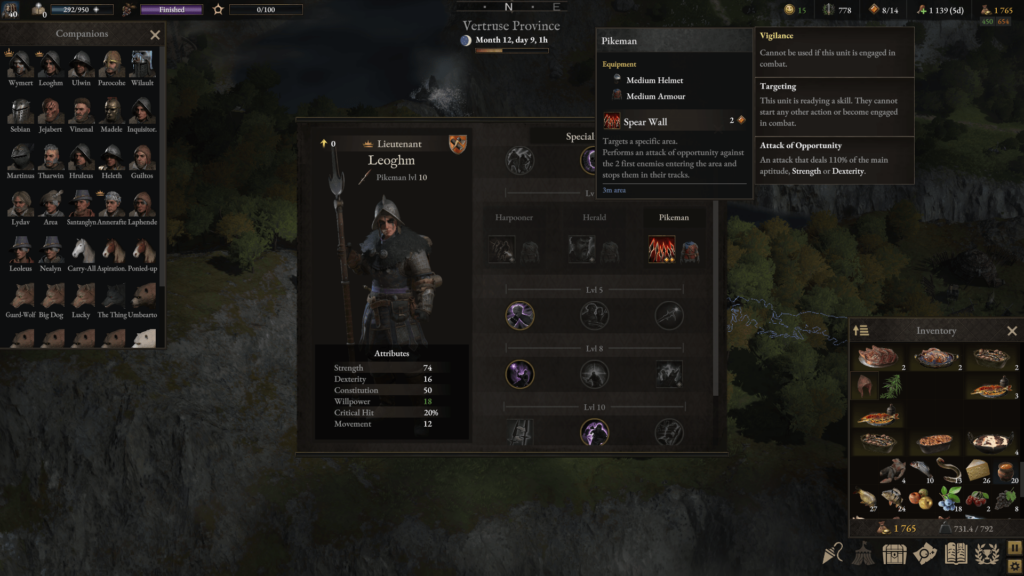
Adding a lot of complexity to the combat is the bevy of status effects at play. Destabilized is a fairly rare one, but disables Guard for a few turns. Poison and Burn bypass Armor altogether and can be annoyingly common. They don’t even care about the size of the actual health pool, dealing a percentage of max health. Bleed also works in a similar way-
Look, the important thing is that you’ll have a bunch of tools to deal with combat situations. That’s doubly so once you start getting weirder weapons and stacking up on weapon oils, two of which can be applied at the same time. Want an axe that poisons a target and sets it a flame? You can do it – though it is inadvisable as flame spreads to adjacent targets, like maniacs with fire-poison axes.
And that’s before you account for the fact that even weapons of the same class can have different attack patterns. Regular maces may deal more damage to targets with armor. Inquisitorial bec-de-corbin? Gives out fairly weak whacks, but keeps going and going until it applies fever to the target. And you can apply oils that, say, ignore part of Guard or deal splash damage to surrounding enemies.
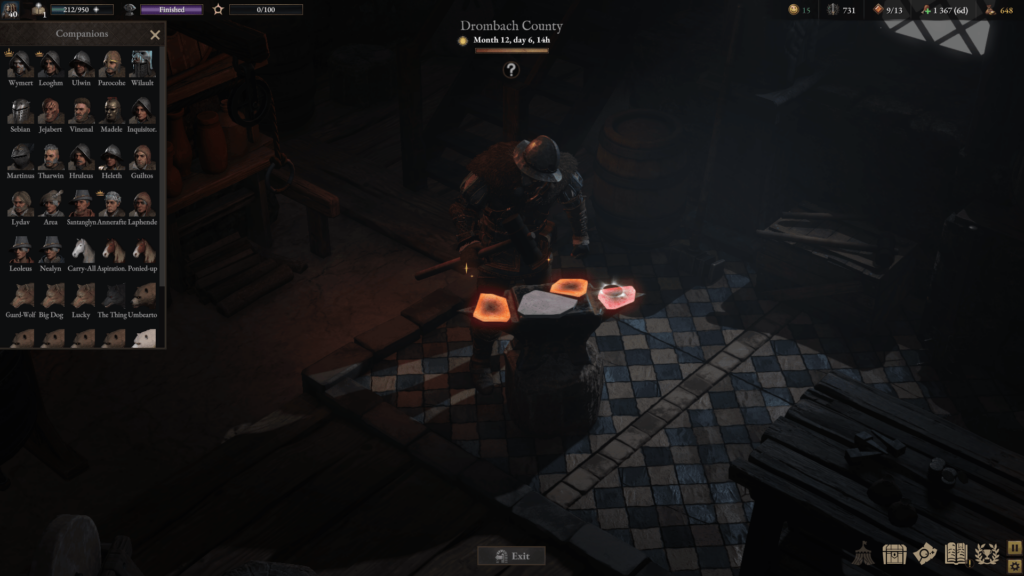
You may understand now why I was lugging around a level 7 bec-de-corbin on a level 10 character.
The combat in Wartales can get pretty nutso even when members of your group aren’t facing death. There will be plenty of status effects going out, special attacks wrecking your plans, wolves dashing past the enemy line to gank archers, thieves throwing poison grenades, throwing poison level-enhancing grenades, and then adding craftable-poison-grenades-available-to-anyone-with-a-free-offhand-slot… It’s madness, it’s beautiful, and unless you waltz into the wrong neighborhood, you don’t even have to optimize all your stats.
I’m going to be level with your
Leveling up is easy in Wartales. There’s a handful of stats, the effects of which are fairly straightforward and you’ll never be at a loss as to where the points are supposed to be assigned. Most classes use Strength as their main stat, only thieves and archers need Dexterity, Willpower is only important until you get it to 15 (which is not hard) to get the special death save…
You also get to choose special class abilities every few levels… but there’s usually only 3 per, so you needn’t suffer analysis paralysis. The subclass choice at level 3 is important, but not overwhelmingly so: aside from giving a kick-ass attack ability, it also determines whether your warrior-types are running around in Medium and Heavy armor.
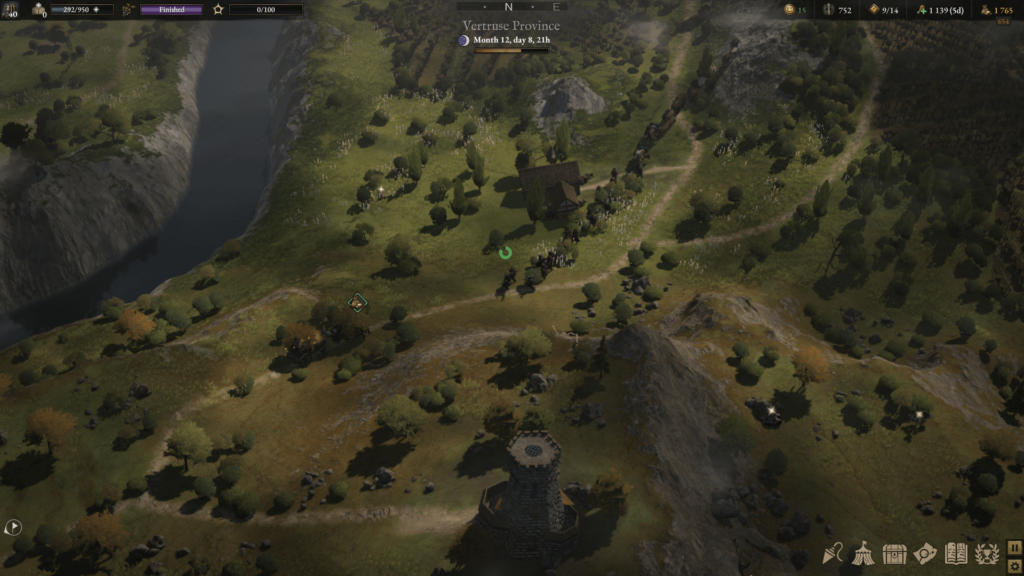
The biggest issue I ran into with my character’s kits – both armor and weapons – were items locked by character levels. This, I believe, is to stop players from cheesing the game by somehow grinding down a small enemy group of a much higher level to deck themselves out in gear that would make them nearly untouchable to level-appropriate enemies. Still, finding level 11 gear and not being able to use it was an issue for me for the entire game.
Except for the one level 11 character I accidentally hired when the rest of my group was level 8 or 9. Heleth immediately became the murder goddess of the group, almost assuredly deleting a lower-level enemy per turn.
Making the economy fun
God, I’m still talking combat, and this is already page 4 of this review. I haven’t even touched the civilian specialties all human hires in Wartales can have! Each of them gives a certain stat bonus, but the more important thing is how they play into the economy of the game.
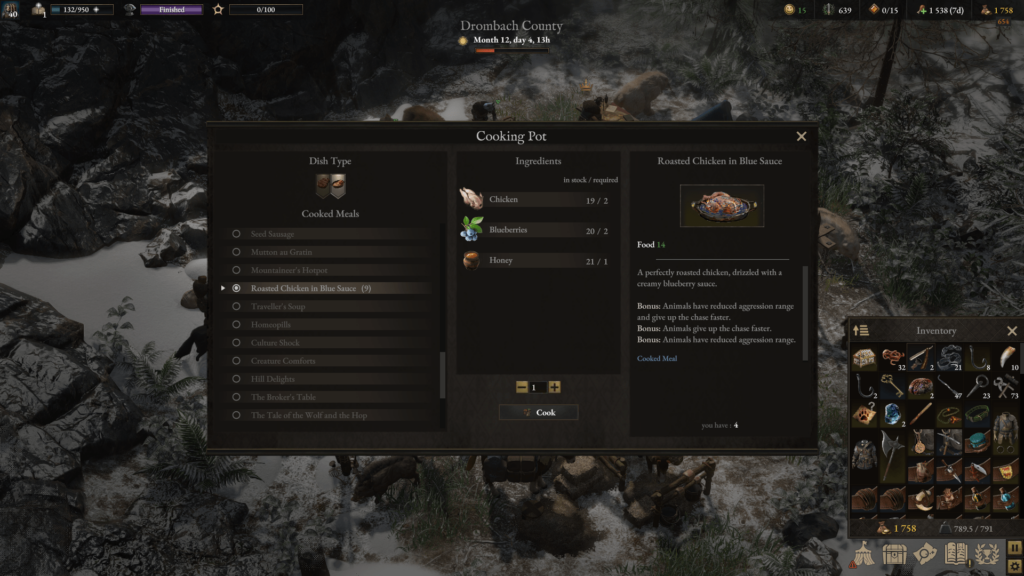
Herbalists make collecting materials more efficient and also create oils, medicine, refine mining materials, craft grenades… Miners mine ore – and are also called in whenever you need to clear some rubble in a quest. Scholars are the only ones who can decipher the texts of the ancients and turn archeological shards into valuable trinkets and unique weapons. You get the idea.
Some of these classes do their work in city crafting screens, others are more active in your camp. The best part is that some require you to play minigames. When forging weapons, smiths will lay out four metal plates on the anvil. Your goal is to hit one when it heats up and starts shining. Hit all four and you’ll have a higher quality item. Hit none and, well, it’s still a sword.
These minigames elevate crafting beyond being just buying with extra steps. It’s fun to hit the circles for mining, to reel in fish, to beat the mini lute hero sections when your bard plays at an inn. But not all specialties have them. It would be obnoxious and tedious if they were present for cooking. You need a lot of food at higher levels, to the point where ordering those meals via menu starts dragging.
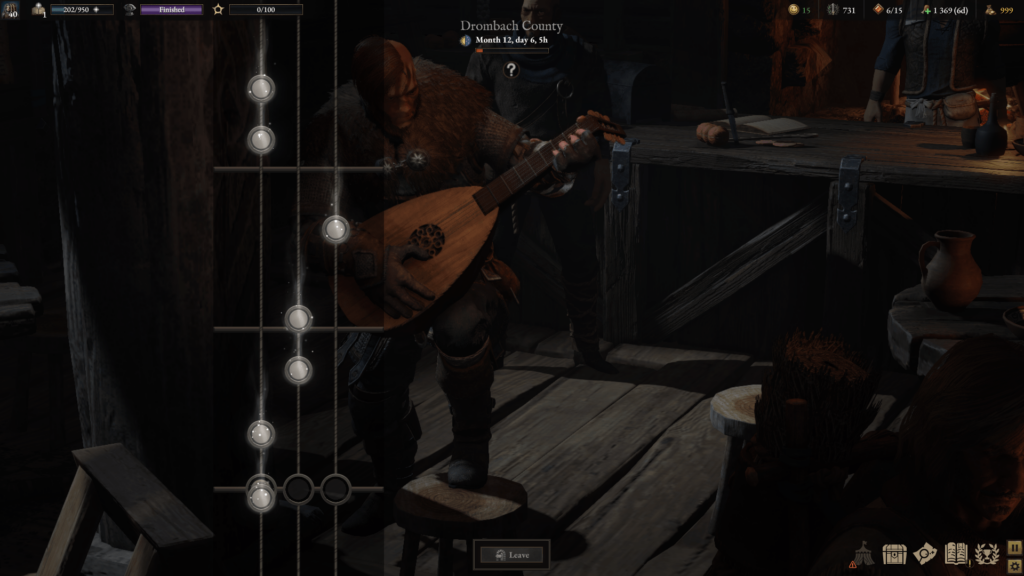
Another thing that redeems crafting in Wartales is that ready-to-go weapons and armor are the exception and not the norm. There are no Pikes’R’Us stores. You may meet a rowing merchant who may offer you a single piece of armor and a single weapon, but that’s it. Instead, it’s all about looting, killing special characters, winning arena bouts or crafting.
And the weapons and armor you craft aren’t on the regular loot table WHILE not being overpowered at the same time. It’s crazy! You’d think these are fairly simple changes to the game economy, but they do so much to make looting and crafting that much more important. I might even go as far as to say that not having weapon stores around is more… realistic!
Plus, some rare and definitely every unique weapon is endlessly upgradeable to keep up with your rise in levels. The price is fairly steep, but if you found a lovely unique pike when you were level 5, you can use it all the way through. So many games break your heart by making you abandon special weapons you find as they just can’t keep up with the level rise… not this one!
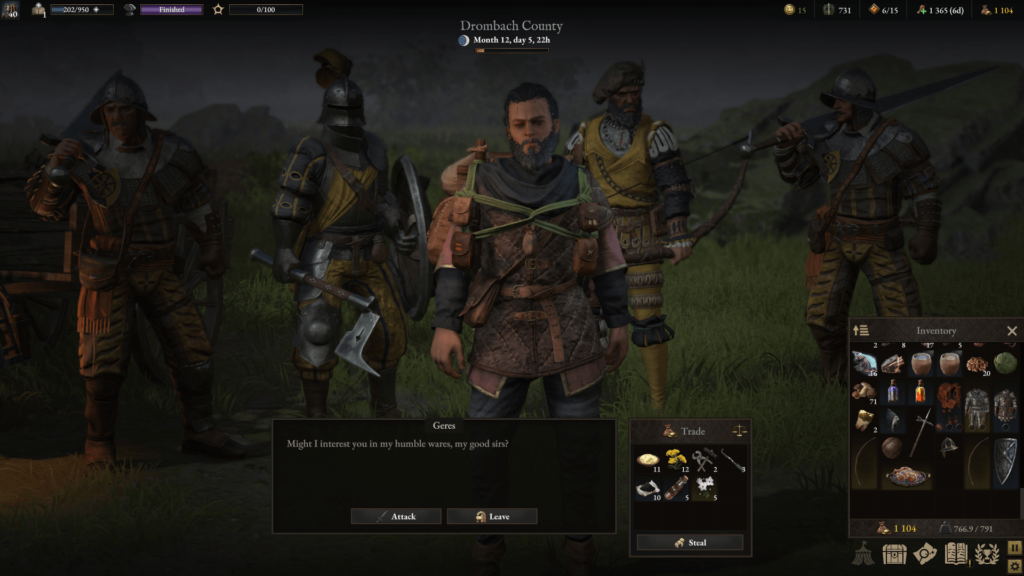
This applies, to an extent, to other craftables. Apothecaries in towns don’t carry infinite inventories of medicines or components to make them with, so herbalists always have work to do. Merchants sell you ingredients, but not finished meals, and higher tier meals are practically never seen in the wild. You have to make your own stuff!
Though by later hours of Wartales, a lot of the early dopamine pumps are exhausted. Eventually, it becomes ever harder to find new crafting recipes. The minor party upgrade system based on achievements isn’t inexhaustible either. By the end, I had completed the military, mercantile, and science trees, with only banditry left (and I wasn’t doing much robbing). You may say that this forces you to focus more on the real stuff – killing people dead – but it still doesn’t feel great.
Then again, I allegedly put 188 hours into the game and Xbox alleges that only 15% completed the first region, so the experience might not be universal.
Feeling good about the inventory screen
It is a pity, though. Wartales is a wonderful game, full of small details that other titles would have done without. All locations that you visit are small 3D vignettes with intractable people and objects. And while some of them are repetitive, just having them – and the limited ability to rotate the view – adds so much to the experience. Looking for items is not pixelbitching, either – holding “Alt” highlights objects in a scene.
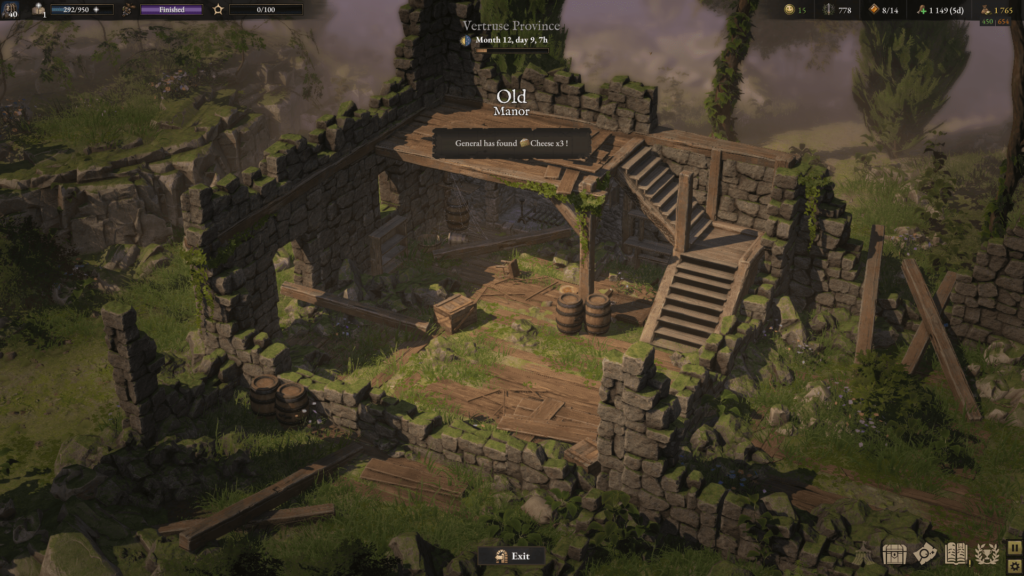
That craftsmanship extends to the inventory as well. First of all, the soft stuff: every item in the game has a description of a few lines. Be it vendor trash or a kickass sword, somebody sat down to write about them. It’s lovely, it adds to your picture of the world. And from the mechanical side, weapons have so few stats – and the meat is also in their attack patterns – that you don’t have to waste time thinking about single-digit increases in, say, dampness resistance.
Look, I’m playing Divinity: The Original Sin right now and the loot mechanics are awful . Every time I get excited to find something, the joy is tampered by the knowledge that any item I get is gonna have a name made of tags and stat increases I can’t care about.
Meanwhile in Wartales, the weapons and armor I find are not only festooned with their own loving descriptions, but also exciting for what they bring to the table.
By the way, I mentioned the in-game prices being steep. Most RPGs and similar titles eventually end up with the player character groaning under the weight of all the money they have no way of meaningfully spending. Not so in Wartales! Your mercenary crew needs to be paid every three rests – and eat every one. Even if you purchase every ridiculous wage shrinking and food saving upgrade, it’s a drain on your resources.
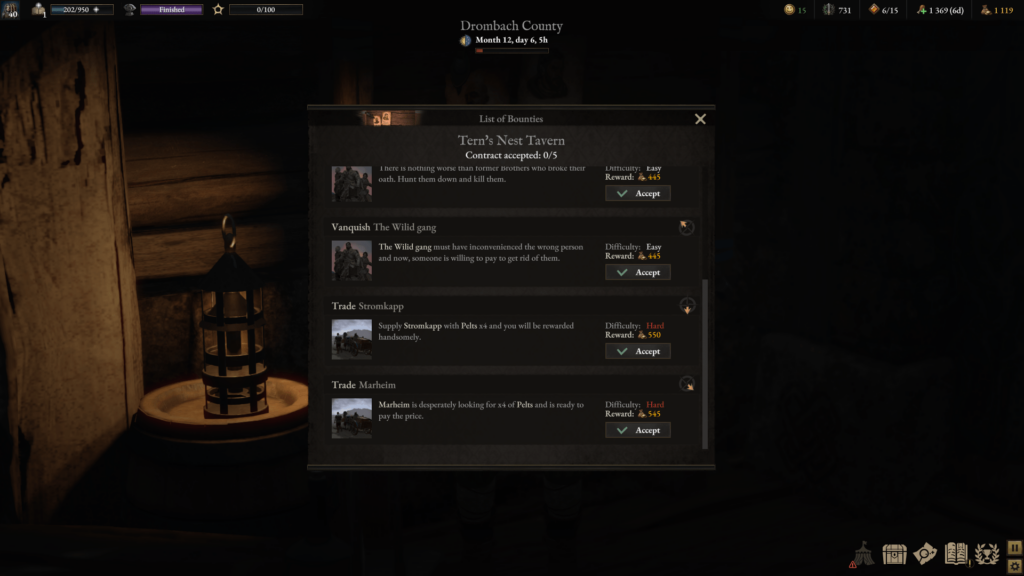
Usually, that’s a very annoying mechanic, only good for keeping debuffs at bay. But in Wartales, paid mercenaries are happy mercenaries, and happy mercenaries have more Valor points. Meanwhile, more advanced meals will give party-wide boosts until the next rest – and they can be combined into feasts (once you find recipes) that give both of the boosts and be more efficient at feeding people! And let me tell you, a mercenary band 40 big that includes at least five bears (of the “furry, shits in the woods” variety) eats a LOT.
So you’re constantly spending money, yes, but that money isn’t going down the drain. You are also spending money for armor repairs and armor repair tools, plus medicine (or medicine precursors) but it never feels as punishing as in Battle Brothers.
Let me show you the world
Wartales is not only well-designed, but also beautiful. The overworld landscapes definitely are, with some regions having really strong character. The fight maps are decidedly less exciting and definitely lacking in variety. Sure, there may be hazardous areas as well as offensive or defensive interactables scattered around them, but they start to repeat fairly fast. On the other hand, I never stopped marveling that character models and portraits account for their armor and weapons, and you can switch off the helmet visuals.
The only real presentation downside is no real unit barks – especially since the game is otherwise fully voiced. Sure, some NPC greetings like “thanks for muzzling that crook” or “you’re not bothering me; I’ve just finished eating my mutton stew” will get old if you visit the same guy a bunch of times, but other than that, sweet, sweet voice acting.
Game good
In conclusion, the Wartales review seems to be out of control, just like my gameplay time. But the game itself is worthy of a spot next to Mount & Blade and Battle Brothers as top medieval mercenary sims. Now, if only one of these devs had the good sense to pitch Games Workshop a Warhammer Fantasy adaptation of their game…

